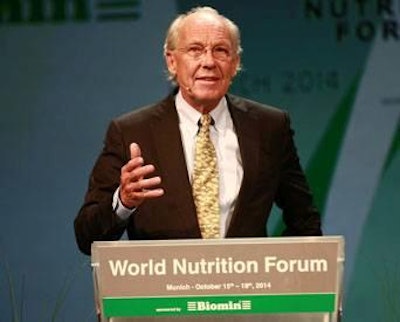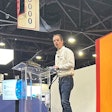
The Biomin World Nutrition Forum, which took place in Munich in October, certainly gave delegates food for thought. With a focus on sustainability, presentations looked at how businesses can be made more sustainable, but alongside this there were warnings on what could happen to the planet if action is not taken.
Growth in output comes at a cost. Michael Eder, Biomin CEO Americas, reminded delegates that the rising population, global warming and changes in economic development are leading to serious problems that will need to be resolved and that, if we continue to waste resources, by 2040, we will need the resources of two Earths to satisfy demand.
Failing to change
This situation is avoidable, but how quickly society is willing to change is another matter. The consequences of failure were detailed by Jorgen Randers of the BI Norwegian Business School, who offered a global forecast for the next 40 years.
The Limits to Growth report, published in 1972, argued that humanity will allow its footprint to grow beyond levels that can be sustained in the long run. Its arguments were rejected.
Now, however, we know better, but are we doing enough? The UN Intergovernmental Panel on Climate Change was established more than 25 years ago and, had we listened to its advice, we would already be well underway in efforts to reduce greenhouse gas emissions.
“It is surprisingly cheap and easy to reduce emissions,” Randers said. “All it takes is a shift of 1-2 percent of the labor force and invested capital from ‘dirty’ to ‘clean’ activity. But instead, we have spent 25 years in fruitless international negotiations, with little impact on global emissions.”
So what will happen over the next 40 years? According to Randers, society will face ever more problems: depletion, pollution, climate change, inequity and social strife.
“I assume these problems will finally be met with increasing investment in solutions, but not before the problems become intense, only afterwards when repair costs are unavoidable,” he said.
Global growth will slow, but not fast enough to avoid a climate crisis mid-century. Similarly, the global population will peak and then slow. And while many developing economies will catch up with leading economies, many will not.
New ways of thinking
More positively, Randers believes there will be a shift toward less carbon-intensive energy sources over the next 40 years and this will accelerate as society becomes more concerned about climate change.
To solve climate change, global society needs to shift investment flows from what is most profitable to what benefits society most in the long run.
Sadly, Randers said, capitalism won’t do this. Capitalism is made to allocate money to what is profitable, not to what society needs. Furthermore, he said, democratic parliaments seem unable to pass the regulations that would align maximum profitability and societal interests. Democratic parliaments do what the voters want, and most voters are against solutions that require higher taxes, more expensive gasoline, or higher electricity prices in the short term.
Without a change in attitudes and action, by the mid-21st century, an ever-growing share of a nation’s labor and capital will be used to repair climate damage and to access more expensive resources, handle pollution problems and provide security, he warned, and after-tax income for citizens will be lower.
A route forward
Against this vision of the future, attendees were told that it was in their hands to make a change.
How to ensure sustainable production was examined by Marty Matlock, of the University of Arkansas, who argued that the environmental impacts of increasing production must be addressed, and that reducing environmental impacts, improving economic well-being and creating more resilient communities will require a transparent, science-based, and outcomes-driven sustainability strategy for continuous improvement.
The framework for a sustainability strategy that supports continuous improvements includes three primary stages: defining, measuring and implementing, he said.
The define stage requires a definition of sustainability for the enterprise in question, defining key performance indicators (KPIs) that represent the enterprise’s important elements of sustainability, and selection of metrics for each.
The definition of what sustainability means for the individual enterprise often is overlooked, and this is a mistake. Animal agriculture producers must clearly understand the scope of their sustainability strategy prior to its adoption and implementation.
For animal agriculture producers, the definition of sustainability should contain four primary domains: community, economics, environment and animal welfare.
Seeking agreement
Developing the list of KPIs with stakeholders can result in increased trust and agreement across stakeholders – and this can increase the range of acceptable options. KPIs should meet the following criteria:
- Science base
- Outcomes driven
- Technology neutral
- Transparent
KPIs often are categorized as efficiency or impact indicators. Efficiency indicators are those that improve a unit of production output per unit of input, such as kg of meat per kg of feed. Increasing efficiency indicators can have a double advantage: it increases sustainability but also reduces production costs.
It should be remembered that KPIs are not the same as metrics, Matlock said. Metrics are the things we can measure, while KPIs are the things we care about. In most cases, we cannot measure KPIs, but we can measure some characteristics that inform the KPIs. For example, feed conversion efficiency is a very common KPI, with several metrics.
Once the KPIs and metrics are identified and prioritized, the enterprise should start the measurement stage. This includes benchmarking each KPI, implementing a monitoring program to assess each metric and developing goals to improve each KPI. The benchmark metrics for each KPI must be publicly reported if the process is to be legitimate. Developing goals for each KPI is, perhaps, the most critical step in a continuous sustainability strategy. The goals will drive priorities in decisions across the enterprise.
Getting things done
The implementation stage of continuous improvement begins with the declaration of goals, as this is when performance timelines are started. Strategies should be properly detailed to ensure legitimacy.
So long as the enterprise is achieving its strategic goals, the processes by which management accomplishes those goals should remain within the enterprise, giving the producer the authority to innovate and adapt processes without intervention. The alternative is that stakeholders dictate practices and procedures for the new enterprise, often based on ideological rather than scientific criteria.
The status of each strategic goal should be reported annually, with a more in-depth report published every five years. The five-year report should include a multi-stakeholder initiative process for review of outcomes, processes and emerging concerns. Proposed adaptations to the strategic goals, including KPIs, metrics and implementation practices, should be described.
This process should be an ongoing part of the enterprise’s continuous improvement strategy, and should be effective in expanding opportunities for prosperity in a rapidly changing world.



















